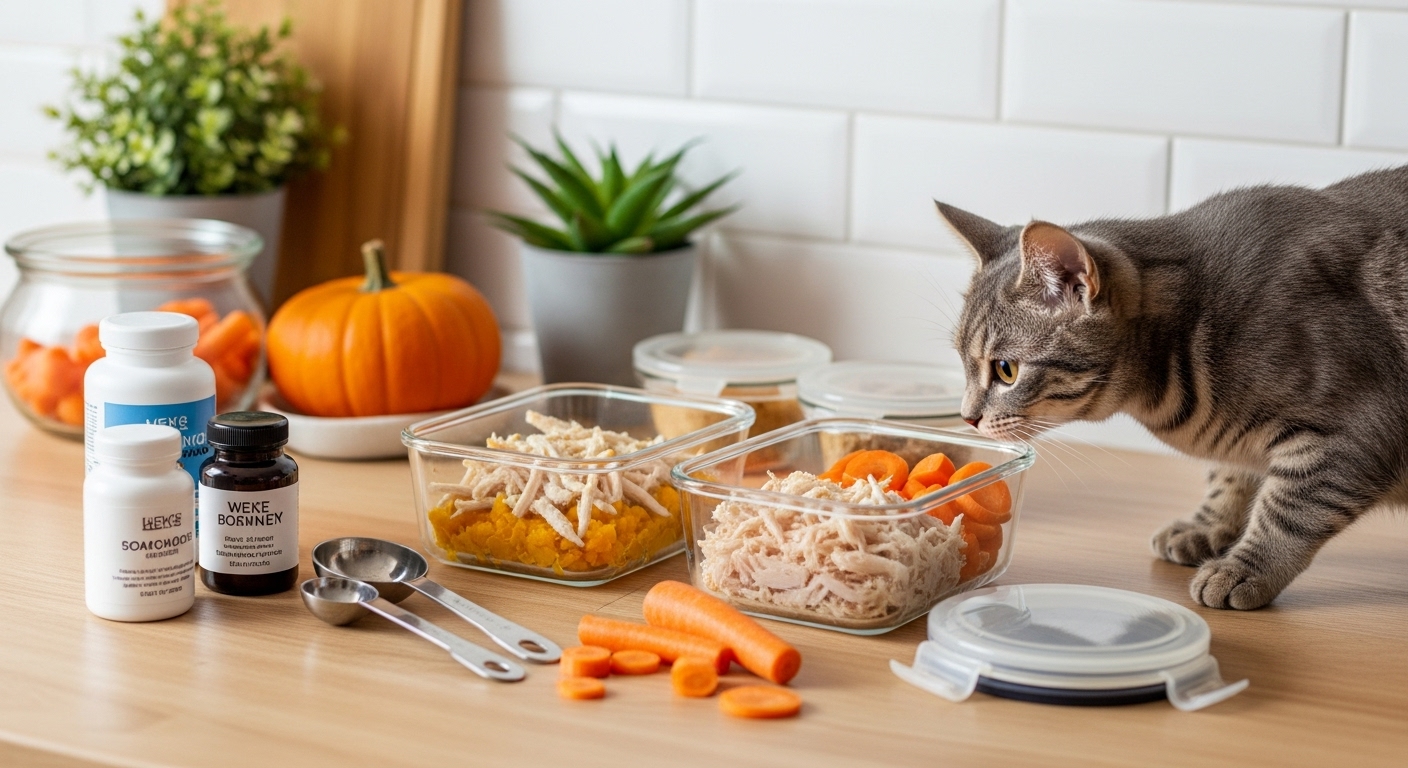🐱 Intro: Because Your Cat Deserves More Than Just Kibble
Hey bestie! 👋 If you’re a proud cat parent, you already know our feline friends are picky eaters with big personalities—but did you know that their nutrition plays a massive role in their energy, coat shine, digestion, and even mood?
Feeding your cat isn’t just about tossing dry food in a bowl. It’s about supporting their instinctive needs with the right nutrients—and yes, you can totally meal-prep for your cat (hello, time-saving win!).
In this science-backed guide, we’ll cover the essentials of feline nutrition, common mistakes to avoid, and how to whip up easy batch-cooked meals that your kitty will adore.
🧠 Why Nutrition Matters (More Than You Think)
Cats are obligate carnivores, which means they require nutrients found only in animal products to survive. Unlike dogs, they can’t thrive on plant-based or high-carb diets. Protein, fat, amino acids (like taurine), vitamins, and minerals are their lifeline.
Here’s why proper nutrition is non-negotiable:
- 🐟 Supports muscle growth and repair
- 🧠 Keeps cognitive function sharp
- 💩 Aids digestion and reduces litter box issues
- ✨ Promotes a shiny coat and healthy skin
- 🧬 Prevents long-term diseases like diabetes or kidney issues
🍗 Macronutrients & Micronutrients: What Cats Really Need
Let’s break it down. Think of this as your go-to cat nutrition cheat sheet:
🔹 Protein
Primary energy source for cats. Animal-based proteins like chicken, turkey, fish, and beef are ideal.
🔹 Fats
Essential fatty acids like omega-3 and omega-6 are crucial for coat health and energy. Fish oils or animal fats are great sources.
🔹 Taurine
This amino acid is vital—a deficiency can lead to blindness or heart issues. Only found in animal tissue (especially heart and liver).
🔹 Vitamins & Minerals
Key players:
- Vitamin A (from liver, not carrots!)
- Vitamin D (from fish or supplements)
- Calcium & Phosphorus (for bones and teeth)
💡 Pro Tip: Cats can’t synthesize many nutrients on their own, so balanced meals are key!
🥩 Safe & Nutritious Foods for Cats (and What to Avoid)
✅ Cat-Safe Foods to Include:
- Chicken (cooked, skinless)
- Turkey
- Salmon (fully cooked)
- Tuna (occasionally)
- Beef (lean cuts)
- Liver & heart (in moderation)
- Pumpkin (great for digestion)
- Eggs (cooked only)
❌ Avoid These No-Nos:
- Onions & garlic (toxic)
- Raw fish or raw eggs (risk of bacteria)
- Chocolate, caffeine, alcohol
- Bones (can splinter and cause injury)
- Dairy (most cats are lactose intolerant)
- Dog food (lacks feline-specific nutrients)
🥘 DIY Batch Cooking for Cats: Save Time, Serve Health
If you’re ready to take control of your cat’s diet, meal-prepping at home is purr-fect. Not only can you control what goes in, but you’ll also avoid preservatives and fillers common in store-bought options.
🧺 Benefits of Batch Cooking:
- Cheaper in the long run
- Customizable for your cat’s needs (age, weight, allergies)
- Less daily hassle—just defrost and serve!
- Healthier, fresher ingredients
🍽️ Sample Batch-Cooked Recipe: Chicken & Pumpkin Power Bowl
This simple, balanced recipe is vet-approved and freezer-friendly.
🔹 Ingredients (Makes 5-6 servings):
- 1 lb boneless, skinless chicken thighs
- ½ cup cooked pumpkin (plain, no sugar/spices)
- 2 boiled eggs (chopped)
- ¼ cup boiled carrots (mashed)
- 1 tbsp fish oil or chicken fat
- Supplement mix (vet-recommended taurine, calcium, vitamin E)
🔹 Step-by-Step Instructions:
1. Cook the Chicken:
Boil or bake chicken thighs until fully cooked. Shred finely once cooled.
2. Prep the Veggies:
Boil carrots until soft. Mash with a fork. Use canned plain pumpkin or roast your own.
3. Boil Eggs:
Hard-boil eggs, peel, and chop finely.
4. Mix Everything:
In a large bowl, combine chicken, pumpkin, carrots, and eggs. Add fish oil and supplements.
5. Portion & Store:
Scoop into airtight containers or silicone freezer molds. Freeze individual servings. Defrost in fridge before use.
6. Serve:
Serve at room temperature. Make sure it’s not too hot or too cold for kitty’s sensitive whiskers!
🐾 Serving Size: Around 2–4 oz per meal, depending on your cat’s size and activity level. Ask your vet for a personalized plan!
🧼 Storage & Safety Tips
- 🧊 Freeze meals for up to 3 weeks
- 🧯 Always label containers with date
- ❄️ Defrost overnight in the fridge—not at room temp
- 🐈 Serve in clean dishes to prevent bacteria build-up
- 👩⚕️ Check with your vet before switching to homemade full-time
🧃 Hydration Matters: Don’t Skip This!
Cats often don’t drink enough water—especially if they’re used to dry kibble. Homemade food usually has more moisture, but always provide fresh water nearby. Consider adding a cat fountain—they love running water!
💧 Pro Tip: Mix in a tablespoon of warm water or unsalted chicken broth into meals for extra hydration.
💬 Final Meow: Your Cat’s Health Starts in the Bowl
Feeding your cat isn’t just a chore—it’s an act of love. 💛 By learning about feline nutrition and trying out easy batch-cooked meals, you’re setting your furry friend up for a long, happy life filled with zoomies, snuggles, and sassy attitude.
And don’t stress, bestie. You don’t have to go full Gordon Ramsay overnight. Start small, test recipes, and watch your kitty glow from the inside out.

